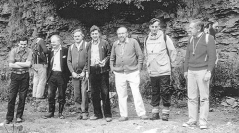

 Comptes Rendus Palevol
1 (6) - Pages 335-345
Comptes Rendus Palevol
1 (6) - Pages 335-345D’Orbigny’s stratigraphic contributions were enormous, both practical and theoretical. In his practice, d’Orbigny realised the central importance of using fossil faunas to correlate strata across different countries. His ‘ succession chronologique des âges du monde ’ (of 1852) recognised 5 periods and 27 stages (ignoring his ‘époque actuelle ’). The great majority of the latter were from two Periods, Jurassic (stages 7 to 16) or Cretaceous (17 to 23). D’Orbigny described the palaeontological characteristics, and geographical extensions, of each. Some stages he based on countries he never visited and although he never specified ‘stratotype’ localities, he referred to some as ‘étalon’, ‘le mieux’ or ‘le plus beau’. These leads proved crucial when, in the mid 20th century, stratigraphers realised that definitions of chrono-stratal units must be attempted. The first attempts at typification simply followed zoology, where a type specimen tries to define a central position within the morphological variation of a species. In 1962, an early attempt was made to define Jurassic stages by three type horizons at different type localities (or stratotypes as they were now called) for each. A central horizon was chosen as ‘lectotype section’ and upper and lower boundaries for each were defined elsewhere. In France, it was preferred to investigate original intentions at named localities, through unit-stratotypes . These allowed some nationalistic pride, since France was the home of so many d’Orbignyan stages. 1980 saw the publication Les Étages français et leurs Stratotypes. However, British Silurian stratigraphers had realised that such zoologically based concepts would produce conflict, when any defined upper boundary stratotype conflicted with the defined lower boundary of a superjacent unit. They suggested, from 1962, to define only lower boundaries, via ‘golden spikes’, at basal-boundary stratotypes . This was the method chosen for the basal Devonian stratotype at Klonk, Czech Republic, defined in 1972, and a method adopted globally from 1986. However, this was when correlations were still largely based on fossils. The explosion of so many other stratigraphies since, based on magnetic or chemical records, events etc, has produced a first reaction against the idea that such stratotypes should be so defined, while a second, potentially more major claim, is that any ‘golden spike’ concept may no longer ‘glitter’, as competing stratotype concepts may be holding back stratigraphic progress.
History, stratotype, Devonian, basal boundary definitions